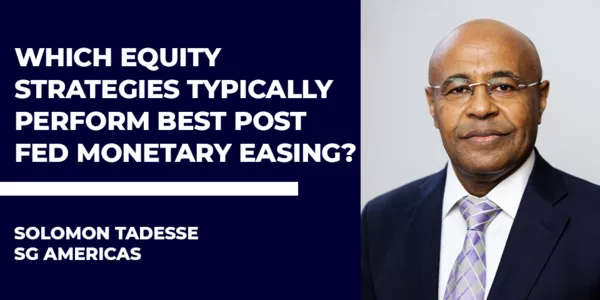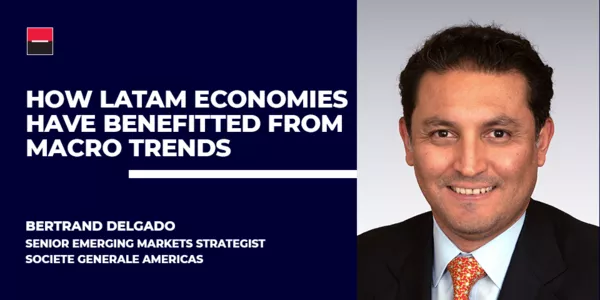
Healthcare companies step up collaboration and innovation
A year into a devastating global healthcare crisis, the healthcare industry has gone into overdrive to find and execute solutions. Larry Williamson, head of healthcare banking at Societe Generale, Americas, has been banking the sector for over 15 years and has developed many long-term relationships with leading global healthcare companies. We talked to him about how the industry has evolved during the last year and what to expect going forward
 |
| Larry Williamson |
Q: The life sciences industry is inherently innovative. What have you learned from your close relationships with leadership inside these companies about how they are currently innovating to meet the world’s immediate healthcare needs?
LW: Life sciences is in constant evolution. Drug and medical technology innovation are the lifeblood of the industry, and today’s environment with the Covid-19 pandemic has created unprecedented levels of innovation whether it’s in treatment, testing, and, of course, in developing vaccines. What has been interesting is the level of collaboration that this environment has engendered – with cross-corporate joint efforts, public-private partnerships, government and philanthropic funding, enhanced end-to-end global supply chains, depending on what works best for each organization. It’s all added up to safely and efficiently developing healthcare solutions to the pandemic in front of us.
Another question is whether these models stick. From my perspective, many of the pandemic-era approaches are leverageable and can be used going forward when appropriate to specific objectives. Beyond the pandemic, the pace of change for developing drugs and use of technology has not been linear but continues to accelerate. In biotechnology, for example, genetic-based advances are already seeing that acceleration in both the science and methodologies. The level of innovation and pace of change are moving in a positive direction for both companies and for society.
Q: One of the largest if not the largest investments for life sciences companies is research and development. How has R&D fared during the Covid-19 pandemic?
LW: It’s important to keep in mind, in that despite the pandemic, the mainstream R&D programs and objectives have continued apace as well. Those haven’t been jeopardized and investment funding is available. The largest companies with broader research portfolios have access to capital for research even while investing hundreds of millions or more into pandemic-era solutions, while the specialized and emerging companies may have specific financing opportunities and needs. In the end, many of these companies are taking the same approach they did before 2020, whether it’s fundraising through venture capital, strategic partnerships or public listing.
Beyond considerations related to the pandemic, the ongoing challenge within R&D – one with which all of the companies are very familiar - is how to best allocate investment to achieve the best scientific outcomes. And this priority differentiates by life sciences subsegment. Within pharma and biotech, for example, these can be very binary outcomes, whereas within medtech, where it may be more of a case of continuous improvement of solutions, the scientific approach and prioritization of finite R&D investment capital remains a paramount consideration for companies going forward.
Q: Has the pandemic created fundamental change for these companies, in terms of how they approach their business and their future outlook?
LW: Our life sciences clients are continuously striving to enhance how they operate and develop new health solutions in the most effective way. But fundamentally, the pandemic has reinforced the true value of public health security – whether it be getting us through a pandemic or avoiding or treating a chronic condition. In essence, the pandemic has underscored the need to continue to address health requirements—both treatments and preventative solutions. It’s a positive mindset as the sector is going to be a main driver and contributor to improvement to society.
Q: Speaking of priorities with increasing visibility, how does Societe Generale help support this industry with respect to ESG and corporate social responsibility?
LW: The life sciences industry has, by its underlying nature, a positive component to social responsibility and ESG given its core mission to enhance the health and well-being of individuals and society as a whole. One focus we see repeatedly is making healthcare accessible to all. You see that evidenced in many ways such as education, clinical delivery, government partnership, geographic outreach, and patient assistance programs. One of our teams in the bank has worked to develop project finance-type structures to support global accessibility in emerging markets for prevention and treatment of specific diseases to provide both a funding solution as well as to contribute to the scalability and sustainability of the project.
As part of an overall ESG commitment and strategy, some companies have also utilized ESG-based financing such as social responsibility bonds, with use of proceeds for eligible projects and “sustainability-linked” bonds that reference specific KPIs linked to specific sustainability objectives. This is not unique to healthcare, but we anticipate seeing more financing of this type in the sector.
Q: Finally, what is the nature of the financing currently available for healthcare companies and were there challenges in financing companies last year that you expect to change as we enter 2021?
LW: The financing environment remains positive despite all of this past year’s challenges. From a credit and investment standpoint, the solutions and products that life sciences companies provide are generally not discretionary items, at least over the longer term, and the underlying value they bring is well recognized, which supports capital access. Financing continues to be very active with two drivers. First, during the height of the early wave of Covid, many companies were taking steps to reinforce their balance sheets to mitigate and be prepared for uncertainty. Second, in terms of core investments, companies continue to invest in drug and medical technology development, both internally and externally, to best advance the solutions they can offer. We see this in our business as we talk to companies about their capital allocation priorities and work to address specific capital needs with our corporate finance, debt and equity capital markets teams, ultimately delivering the best funding solutions relative to their specific objectives.
Disclaimer
Unless otherwise stated, any views or opinions expressed herein are solely those of Larry Williamson and may differ from the views and opinions of others at, or other departments or divisions of, Societe Generale (“SG”) and its affiliates. No part of Larry Williamson’s compensation was, is or will be related, directly or indirectly to the specific views expressed herein. This material is provided for information purposes only and is not intended as a recommendation or an offer or solicitation for the purchase or sale of any security or financial instrument. The information contained herein has been obtained from, and is based upon, sources believed to be reliable, but SG and its affiliates make no representation as to its accuracy and completeness. The views and opinions contained herein are those of the author of this material as of the date of this material and are subject to change without notice. Neither Larry Williamson nor SG has any obligation to update, modify or otherwise notify the recipient in the event any information contained herein, including any opinion or view, changes or becomes inaccurate. To the maximum extent possible at law, SG does not accept any liability whatsoever arising from the use of the material or information contained herein.
This publication should not be construed as investment research as it has not been prepared in accordance with legal requirements designed to promote the independence of investment research. Therefore, even if it contains a research recommendation, it should be treated as a marketing communication. This publication is not subject to any prohibition on dealing ahead of the dissemination of investment research. Notwithstanding the preceding sentence SG is required to have policies in place to manage the conflicts which may arise in the production of its research, including preventing dealing ahead of investment research.




